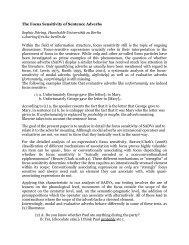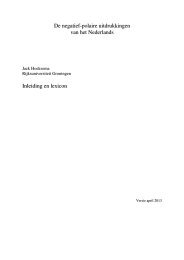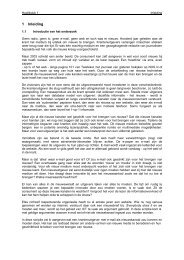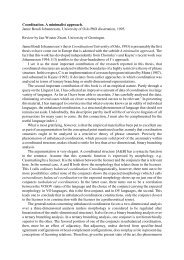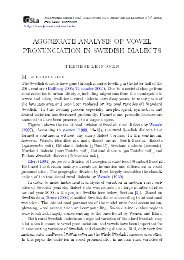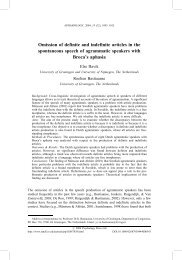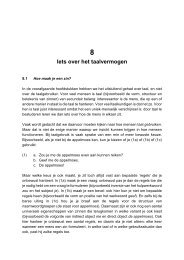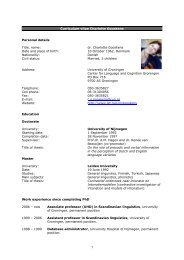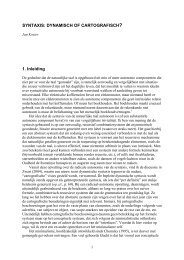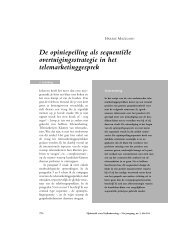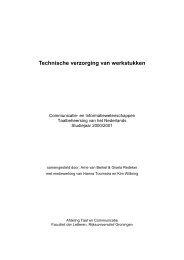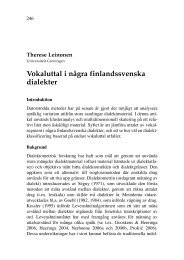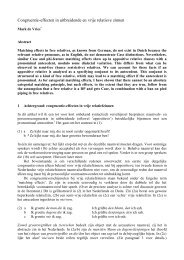Latent Semantic Analysis - An overview of singular value ...
Latent Semantic Analysis - An overview of singular value ...
Latent Semantic Analysis - An overview of singular value ...
Create successful ePaper yourself
Turn your PDF publications into a flip-book with our unique Google optimized e-Paper software.
Introduction<br />
Preliminaries<br />
LSA: technique and example<br />
Applications<br />
<strong>Latent</strong> <strong>Semantic</strong> <strong><strong>An</strong>alysis</strong><br />
<strong>An</strong> <strong>overview</strong> <strong>of</strong> <strong>singular</strong> <strong>value</strong> decomposition<br />
in order to tackle semantics<br />
Tim Van de Cruys<br />
March 22, 2006<br />
Tim Van de Cruys <strong>Latent</strong> <strong>Semantic</strong> <strong><strong>An</strong>alysis</strong><br />
university-logo
Outline<br />
1 Introduction<br />
Introduction<br />
Preliminaries<br />
LSA: technique and example<br />
Applications<br />
2 Preliminaries<br />
Term-document matrix<br />
Vector Space Measures<br />
3 LSA: technique and example<br />
Singular Value Decomposition<br />
Example<br />
4 Applications<br />
Clustering<br />
Varia<br />
Tim Van de Cruys <strong>Latent</strong> <strong>Semantic</strong> <strong><strong>An</strong>alysis</strong><br />
university-logo
Introduction<br />
Preliminaries<br />
LSA: technique and example<br />
Applications<br />
<strong>Latent</strong> <strong>Semantic</strong> <strong><strong>An</strong>alysis</strong>: Introduction 1/2<br />
Application <strong>of</strong> a mathematical/statistical technique to<br />
simulate how humans learn the semantics <strong>of</strong> a word<br />
LSA finds ‘latent semantic dimensions’ according to which<br />
words and documents can be identified<br />
Words (and passages) are represented as high-dimensional<br />
vectors in this semantic space<br />
Goal: counter data sparseness (poverty <strong>of</strong> the stimulus) and<br />
get rid <strong>of</strong> noise<br />
Tim Van de Cruys <strong>Latent</strong> <strong>Semantic</strong> <strong><strong>An</strong>alysis</strong><br />
university-logo
Introduction<br />
Preliminaries<br />
LSA: technique and example<br />
Applications<br />
<strong>Latent</strong> <strong>Semantic</strong> <strong><strong>An</strong>alysis</strong>: Introduction 1/2<br />
Application <strong>of</strong> a mathematical/statistical technique to<br />
simulate how humans learn the semantics <strong>of</strong> a word<br />
LSA finds ‘latent semantic dimensions’ according to which<br />
words and documents can be identified<br />
Words (and passages) are represented as high-dimensional<br />
vectors in this semantic space<br />
Goal: counter data sparseness (poverty <strong>of</strong> the stimulus) and<br />
get rid <strong>of</strong> noise<br />
Tim Van de Cruys <strong>Latent</strong> <strong>Semantic</strong> <strong><strong>An</strong>alysis</strong><br />
university-logo
Introduction<br />
Preliminaries<br />
LSA: technique and example<br />
Applications<br />
<strong>Latent</strong> <strong>Semantic</strong> <strong><strong>An</strong>alysis</strong>: Introduction 1/2<br />
Application <strong>of</strong> a mathematical/statistical technique to<br />
simulate how humans learn the semantics <strong>of</strong> a word<br />
LSA finds ‘latent semantic dimensions’ according to which<br />
words and documents can be identified<br />
Words (and passages) are represented as high-dimensional<br />
vectors in this semantic space<br />
Goal: counter data sparseness (poverty <strong>of</strong> the stimulus) and<br />
get rid <strong>of</strong> noise<br />
Tim Van de Cruys <strong>Latent</strong> <strong>Semantic</strong> <strong><strong>An</strong>alysis</strong><br />
university-logo
Introduction<br />
Preliminaries<br />
LSA: technique and example<br />
Applications<br />
<strong>Latent</strong> <strong>Semantic</strong> <strong><strong>An</strong>alysis</strong>: Introduction 1/2<br />
Application <strong>of</strong> a mathematical/statistical technique to<br />
simulate how humans learn the semantics <strong>of</strong> a word<br />
LSA finds ‘latent semantic dimensions’ according to which<br />
words and documents can be identified<br />
Words (and passages) are represented as high-dimensional<br />
vectors in this semantic space<br />
Goal: counter data sparseness (poverty <strong>of</strong> the stimulus) and<br />
get rid <strong>of</strong> noise<br />
Tim Van de Cruys <strong>Latent</strong> <strong>Semantic</strong> <strong><strong>An</strong>alysis</strong><br />
university-logo
Introduction<br />
Preliminaries<br />
LSA: technique and example<br />
Applications<br />
<strong>Latent</strong> <strong>Semantic</strong> <strong><strong>An</strong>alysis</strong>: Introduction 2/2<br />
What is <strong>Latent</strong> <strong>Semantic</strong> <strong><strong>An</strong>alysis</strong> technically speaking?<br />
The application a <strong>singular</strong> <strong>value</strong> decomposition<br />
to a term-document matrix<br />
to improve vector space measures<br />
Tim Van de Cruys <strong>Latent</strong> <strong>Semantic</strong> <strong><strong>An</strong>alysis</strong><br />
university-logo
Introduction<br />
Preliminaries<br />
LSA: technique and example<br />
Applications<br />
<strong>Latent</strong> <strong>Semantic</strong> <strong><strong>An</strong>alysis</strong>: Introduction 2/2<br />
What is <strong>Latent</strong> <strong>Semantic</strong> <strong><strong>An</strong>alysis</strong> technically speaking?<br />
The application a <strong>singular</strong> <strong>value</strong> decomposition<br />
to a term-document matrix<br />
to improve vector space measures<br />
Tim Van de Cruys <strong>Latent</strong> <strong>Semantic</strong> <strong><strong>An</strong>alysis</strong><br />
university-logo
Introduction<br />
Preliminaries<br />
LSA: technique and example<br />
Applications<br />
<strong>Latent</strong> <strong>Semantic</strong> <strong><strong>An</strong>alysis</strong>: Introduction 2/2<br />
What is <strong>Latent</strong> <strong>Semantic</strong> <strong><strong>An</strong>alysis</strong> technically speaking?<br />
The application a <strong>singular</strong> <strong>value</strong> decomposition<br />
to a term-document matrix<br />
to improve vector space measures<br />
Tim Van de Cruys <strong>Latent</strong> <strong>Semantic</strong> <strong><strong>An</strong>alysis</strong><br />
university-logo
Introduction<br />
Preliminaries<br />
LSA: technique and example<br />
Applications<br />
<strong>Latent</strong> <strong>Semantic</strong> <strong><strong>An</strong>alysis</strong>: Introduction 2/2<br />
What is <strong>Latent</strong> <strong>Semantic</strong> <strong><strong>An</strong>alysis</strong> technically speaking?<br />
The application a <strong>singular</strong> <strong>value</strong> decomposition<br />
to a term-document matrix<br />
to improve vector space measures<br />
Tim Van de Cruys <strong>Latent</strong> <strong>Semantic</strong> <strong><strong>An</strong>alysis</strong><br />
university-logo
Introduction<br />
Preliminaries<br />
LSA: technique and example<br />
Applications<br />
Bag-<strong>of</strong>-word semantics<br />
Term-document matrix<br />
Vector Space Measures<br />
LSA represents ‘bag-<strong>of</strong>-word’ semantics<br />
Idea that meaning <strong>of</strong> a passage equals the sum <strong>of</strong> the<br />
meaning <strong>of</strong> its words<br />
Meaning = an unordered set <strong>of</strong> word tokens, syntax is not<br />
taken into account<br />
Done by representing several passages in a term-document<br />
matrix<br />
Tim Van de Cruys <strong>Latent</strong> <strong>Semantic</strong> <strong><strong>An</strong>alysis</strong><br />
university-logo
Introduction<br />
Preliminaries<br />
LSA: technique and example<br />
Applications<br />
Bag-<strong>of</strong>-word semantics<br />
Term-document matrix<br />
Vector Space Measures<br />
LSA represents ‘bag-<strong>of</strong>-word’ semantics<br />
Idea that meaning <strong>of</strong> a passage equals the sum <strong>of</strong> the<br />
meaning <strong>of</strong> its words<br />
Meaning = an unordered set <strong>of</strong> word tokens, syntax is not<br />
taken into account<br />
Done by representing several passages in a term-document<br />
matrix<br />
Tim Van de Cruys <strong>Latent</strong> <strong>Semantic</strong> <strong><strong>An</strong>alysis</strong><br />
university-logo
Introduction<br />
Preliminaries<br />
LSA: technique and example<br />
Applications<br />
Bag-<strong>of</strong>-word semantics<br />
Term-document matrix<br />
Vector Space Measures<br />
LSA represents ‘bag-<strong>of</strong>-word’ semantics<br />
Idea that meaning <strong>of</strong> a passage equals the sum <strong>of</strong> the<br />
meaning <strong>of</strong> its words<br />
Meaning = an unordered set <strong>of</strong> word tokens, syntax is not<br />
taken into account<br />
Done by representing several passages in a term-document<br />
matrix<br />
Tim Van de Cruys <strong>Latent</strong> <strong>Semantic</strong> <strong><strong>An</strong>alysis</strong><br />
university-logo
Introduction<br />
Preliminaries<br />
LSA: technique and example<br />
Applications<br />
Bag-<strong>of</strong>-word semantics<br />
Term-document matrix<br />
Vector Space Measures<br />
LSA represents ‘bag-<strong>of</strong>-word’ semantics<br />
Idea that meaning <strong>of</strong> a passage equals the sum <strong>of</strong> the<br />
meaning <strong>of</strong> its words<br />
Meaning = an unordered set <strong>of</strong> word tokens, syntax is not<br />
taken into account<br />
Done by representing several passages in a term-document<br />
matrix<br />
Tim Van de Cruys <strong>Latent</strong> <strong>Semantic</strong> <strong><strong>An</strong>alysis</strong><br />
university-logo
Introduction<br />
Preliminaries<br />
LSA: technique and example<br />
Applications<br />
Term-document matrix 1/2<br />
Consider two documents:<br />
Term-document matrix<br />
Vector Space Measures<br />
België is een koninkrijk in het midden van Europa, met als<br />
ho<strong>of</strong>dstad Brussel. Brussel heeft een Nederlandstalige en een<br />
Franstalige universiteit, maar de grootste studentenstad is<br />
Leuven. Leuven telt 27.000 studenten.<br />
Nederland is een West-Europees land aan de Noordzee. De<br />
ho<strong>of</strong>dstad van Nederland is Amsterdam. Amsterdam telt<br />
twee universiteiten. Groningen is een belangrijke<br />
studentenstad. In Groningen studeren 37.000 studenten.<br />
Tim Van de Cruys <strong>Latent</strong> <strong>Semantic</strong> <strong><strong>An</strong>alysis</strong><br />
university-logo
Introduction<br />
Preliminaries<br />
LSA: technique and example<br />
Applications<br />
Term-document matrix 1/2<br />
Consider two documents:<br />
Term-document matrix<br />
Vector Space Measures<br />
België is een koninkrijk in het midden van Europa, met als<br />
ho<strong>of</strong>dstad Brussel. Brussel heeft een Nederlandstalige en een<br />
Franstalige universiteit, maar de grootste studentenstad is<br />
Leuven. Leuven telt 27.000 studenten.<br />
Nederland is een West-Europees land aan de Noordzee. De<br />
ho<strong>of</strong>dstad van Nederland is Amsterdam. Amsterdam telt<br />
twee universiteiten. Groningen is een belangrijke<br />
studentenstad. In Groningen studeren 37.000 studenten.<br />
Tim Van de Cruys <strong>Latent</strong> <strong>Semantic</strong> <strong><strong>An</strong>alysis</strong><br />
university-logo
Introduction<br />
Preliminaries<br />
LSA: technique and example<br />
Applications<br />
Term-document matrix 1/2<br />
Consider two documents:<br />
Term-document matrix<br />
Vector Space Measures<br />
België is een koninkrijk in het midden van Europa, met als<br />
ho<strong>of</strong>dstad Brussel. Brussel heeft een Nederlandstalige en een<br />
Franstalige universiteit, maar de grootste studentenstad is<br />
Leuven. Leuven telt 27.000 studenten.<br />
Nederland is een West-Europees land aan de Noordzee. De<br />
ho<strong>of</strong>dstad van Nederland is Amsterdam. Amsterdam telt<br />
twee universiteiten. Groningen is een belangrijke<br />
studentenstad. In Groningen studeren 37.000 studenten.<br />
Tim Van de Cruys <strong>Latent</strong> <strong>Semantic</strong> <strong><strong>An</strong>alysis</strong><br />
university-logo
Introduction<br />
Preliminaries<br />
LSA: technique and example<br />
Applications<br />
Term-document matrix 2/2<br />
⎡<br />
⎢<br />
⎣<br />
Term-document matrix<br />
Vector Space Measures<br />
B NL<br />
Groningen 0 2<br />
Leuven 2 0<br />
Amsterdam 0 2<br />
Brussel 2 0<br />
Note: Values for words are transformed to <strong>value</strong>s that represent<br />
their importance in the passage (entropy, mutual information)<br />
⎤<br />
⎥<br />
⎦<br />
Tim Van de Cruys <strong>Latent</strong> <strong>Semantic</strong> <strong><strong>An</strong>alysis</strong><br />
university-logo
Matrix<br />
Introduction<br />
Preliminaries<br />
LSA: technique and example<br />
Applications<br />
⎡<br />
⎢<br />
⎣<br />
Apply cosine similarity measure<br />
Term-document matrix<br />
Vector Space Measures<br />
B NL<br />
Groningen 0 2<br />
Leuven 2 0<br />
Amsterdam 0 2<br />
Brussel 2 0<br />
cos( −→ x , −→ y ) = −→ x · −→ y<br />
| −→ x || −→ y | =<br />
Pn i=1 xi yi<br />
√Pn i=1 x2 Pn i i=1 y 2<br />
i<br />
Examples:<br />
cos(Groningen, Amsterdam) = 4 √ = 1<br />
16<br />
cos(Groningen, Brussel) = 0<br />
√ 16 = 0<br />
⎤<br />
⎥<br />
⎦<br />
Tim Van de Cruys <strong>Latent</strong> <strong>Semantic</strong> <strong><strong>An</strong>alysis</strong><br />
university-logo
Matrix<br />
Introduction<br />
Preliminaries<br />
LSA: technique and example<br />
Applications<br />
⎡<br />
⎢<br />
⎣<br />
Apply cosine similarity measure<br />
Term-document matrix<br />
Vector Space Measures<br />
B NL<br />
Groningen 0 2<br />
Leuven 2 0<br />
Amsterdam 0 2<br />
Brussel 2 0<br />
cos( −→ x , −→ y ) = −→ x · −→ y<br />
| −→ x || −→ y | =<br />
Pn i=1 xi yi<br />
√Pn i=1 x2 Pn i i=1 y 2<br />
i<br />
Examples:<br />
cos(Groningen, Amsterdam) = 4 √ = 1<br />
16<br />
cos(Groningen, Brussel) = 0<br />
√ 16 = 0<br />
⎤<br />
⎥<br />
⎦<br />
Tim Van de Cruys <strong>Latent</strong> <strong>Semantic</strong> <strong><strong>An</strong>alysis</strong><br />
university-logo
Matrix<br />
Introduction<br />
Preliminaries<br />
LSA: technique and example<br />
Applications<br />
⎡<br />
⎢<br />
⎣<br />
Apply cosine similarity measure<br />
Term-document matrix<br />
Vector Space Measures<br />
B NL<br />
Groningen 0 2<br />
Leuven 2 0<br />
Amsterdam 0 2<br />
Brussel 2 0<br />
cos( −→ x , −→ y ) = −→ x · −→ y<br />
| −→ x || −→ y | =<br />
Pn i=1 xi yi<br />
√Pn i=1 x2 Pn i i=1 y 2<br />
i<br />
Examples:<br />
cos(Groningen, Amsterdam) = 4 √ = 1<br />
16<br />
cos(Groningen, Brussel) = 0<br />
√ 16 = 0<br />
⎤<br />
⎥<br />
⎦<br />
Tim Van de Cruys <strong>Latent</strong> <strong>Semantic</strong> <strong><strong>An</strong>alysis</strong><br />
university-logo
Matrix<br />
Introduction<br />
Preliminaries<br />
LSA: technique and example<br />
Applications<br />
⎡<br />
⎢<br />
⎣<br />
Apply cosine similarity measure<br />
Term-document matrix<br />
Vector Space Measures<br />
B NL<br />
Groningen 0 2<br />
Leuven 2 0<br />
Amsterdam 0 2<br />
Brussel 2 0<br />
cos( −→ x , −→ y ) = −→ x · −→ y<br />
| −→ x || −→ y | =<br />
Pn i=1 xi yi<br />
√Pn i=1 x2 Pn i i=1 y 2<br />
i<br />
Examples:<br />
cos(Groningen, Amsterdam) = 4 √ = 1<br />
16<br />
cos(Groningen, Brussel) = 0<br />
√ 16 = 0<br />
⎤<br />
⎥<br />
⎦<br />
Tim Van de Cruys <strong>Latent</strong> <strong>Semantic</strong> <strong><strong>An</strong>alysis</strong><br />
university-logo
Matrix<br />
Introduction<br />
Preliminaries<br />
LSA: technique and example<br />
Applications<br />
⎡<br />
⎢<br />
⎣<br />
Apply cosine similarity measure<br />
Term-document matrix<br />
Vector Space Measures<br />
B NL<br />
Groningen 0 2<br />
Leuven 2 0<br />
Amsterdam 0 2<br />
Brussel 2 0<br />
cos( −→ x , −→ y ) = −→ x · −→ y<br />
| −→ x || −→ y | =<br />
Pn i=1 xi yi<br />
√Pn i=1 x2 Pn i i=1 y 2<br />
i<br />
Examples:<br />
cos(Groningen, Amsterdam) = 4 √ = 1<br />
16<br />
cos(Groningen, Brussel) = 0<br />
√ 16 = 0<br />
⎤<br />
⎥<br />
⎦<br />
Tim Van de Cruys <strong>Latent</strong> <strong>Semantic</strong> <strong><strong>An</strong>alysis</strong><br />
university-logo
Introduction<br />
Preliminaries<br />
LSA: technique and example<br />
Applications<br />
Singular Value Decomposition<br />
Singular Value Decomposition<br />
Example<br />
Mathematical/statistical technique closely related to principal<br />
component analysis, factor analysis<br />
Find the dimensions that explain most variability by finding<br />
eigenvectors <strong>of</strong> matrix<br />
Only keep the n most important dimensions (n=50-1000)<br />
Tim Van de Cruys <strong>Latent</strong> <strong>Semantic</strong> <strong><strong>An</strong>alysis</strong><br />
university-logo
Introduction<br />
Preliminaries<br />
LSA: technique and example<br />
Applications<br />
Singular Value Decomposition<br />
Singular Value Decomposition<br />
Example<br />
Mathematical/statistical technique closely related to principal<br />
component analysis, factor analysis<br />
Find the dimensions that explain most variability by finding<br />
eigenvectors <strong>of</strong> matrix<br />
Only keep the n most important dimensions (n=50-1000)<br />
Tim Van de Cruys <strong>Latent</strong> <strong>Semantic</strong> <strong><strong>An</strong>alysis</strong><br />
university-logo
Introduction<br />
Preliminaries<br />
LSA: technique and example<br />
Applications<br />
Singular Value Decomposition<br />
Singular Value Decomposition<br />
Example<br />
Mathematical/statistical technique closely related to principal<br />
component analysis, factor analysis<br />
Find the dimensions that explain most variability by finding<br />
eigenvectors <strong>of</strong> matrix<br />
Only keep the n most important dimensions (n=50-1000)<br />
Tim Van de Cruys <strong>Latent</strong> <strong>Semantic</strong> <strong><strong>An</strong>alysis</strong><br />
university-logo
SVD: three matrices<br />
Introduction<br />
Preliminaries<br />
LSA: technique and example<br />
Applications<br />
Singular Value Decomposition<br />
Example<br />
Tim Van de Cruys <strong>Latent</strong> <strong>Semantic</strong> <strong><strong>An</strong>alysis</strong><br />
university-logo
Example 1a<br />
⎡<br />
⎢<br />
A ⎢<br />
⎣<br />
U<br />
⎡<br />
⎢<br />
⎣<br />
Introduction<br />
Preliminaries<br />
LSA: technique and example<br />
Applications<br />
B NL<br />
Groningen 0 2<br />
Leuven 2 0<br />
Amsterdam 0 2<br />
Brussel 2 0<br />
0.00 0.71<br />
−0.71 0.00<br />
0.00 0.71<br />
−0.71 0.00<br />
⎤<br />
⎥<br />
⎦ ∗ S<br />
⎤<br />
⎥<br />
⎦ =<br />
2.83 0<br />
0 2.83<br />
Singular Value Decomposition<br />
Example<br />
<br />
∗ V T<br />
<br />
−1 0<br />
0 1<br />
Tim Van de Cruys <strong>Latent</strong> <strong>Semantic</strong> <strong><strong>An</strong>alysis</strong><br />
<br />
university-logo
Example 1b<br />
⎡<br />
⎢<br />
⎣<br />
Introduction<br />
Preliminaries<br />
LSA: technique and example<br />
Applications<br />
B NL B<br />
Groningen 0 2 0<br />
Leuven 2 0 0<br />
Amsterdam 0 2 0<br />
⎤<br />
⎥<br />
⎦ =<br />
Singular Value Decomposition<br />
Example<br />
Brussel 2 0 1<br />
⎡<br />
⎤<br />
0.00 −0.71 0.00 ///// ⎡<br />
⎤<br />
⎢ −0.66 0.00 0.75 /////<br />
⎥ 2.92 0 0/<br />
⎥ ⎢<br />
⎥<br />
U ⎢<br />
⎥<br />
⎢<br />
⎣<br />
0.00 −0.71 0.00 ///// ⎥ ∗ S ⎢ 0 2.83 0/ ⎥<br />
⎣<br />
⎦<br />
⎦<br />
0/ 0/ 0.68 /////<br />
−0.75 0.00 //////// −0.66<br />
∗<br />
V T<br />
⎡<br />
⎤<br />
−0.97 0.00 0.26<br />
⎢<br />
⎣ 0 −1.00 0.00 ⎥<br />
⎦<br />
//////// −0.26 0.00 ///// //////// −0.97<br />
∼ = A ′<br />
⎡<br />
⎤<br />
0.0 2.0 0.0<br />
⎢ 1.9 0.0 0.5 ⎥<br />
⎣ 0.0 2.0 0.0 ⎦<br />
2.1 0 0.6<br />
Tim Van de Cruys <strong>Latent</strong> <strong>Semantic</strong> <strong><strong>An</strong>alysis</strong><br />
university-logo
Introduction<br />
Preliminaries<br />
LSA: technique and example<br />
Applications<br />
Methodological remarks<br />
Clustering<br />
Varia<br />
LSA in CLEF-corpus: 4 years <strong>of</strong> Dutch newspaper texts<br />
(Algemeen Dagblad, NRC Handelsblad)<br />
terms = nouns<br />
documents = articles<br />
20.000 terms * 100.000 documents matrix<br />
reduced to 300 latent semantic dimensions<br />
Tim Van de Cruys <strong>Latent</strong> <strong>Semantic</strong> <strong><strong>An</strong>alysis</strong><br />
university-logo
Introduction<br />
Preliminaries<br />
LSA: technique and example<br />
Applications<br />
Methodological remarks<br />
Clustering<br />
Varia<br />
LSA in CLEF-corpus: 4 years <strong>of</strong> Dutch newspaper texts<br />
(Algemeen Dagblad, NRC Handelsblad)<br />
terms = nouns<br />
documents = articles<br />
20.000 terms * 100.000 documents matrix<br />
reduced to 300 latent semantic dimensions<br />
Tim Van de Cruys <strong>Latent</strong> <strong>Semantic</strong> <strong><strong>An</strong>alysis</strong><br />
university-logo
Introduction<br />
Preliminaries<br />
LSA: technique and example<br />
Applications<br />
Methodological remarks<br />
Clustering<br />
Varia<br />
LSA in CLEF-corpus: 4 years <strong>of</strong> Dutch newspaper texts<br />
(Algemeen Dagblad, NRC Handelsblad)<br />
terms = nouns<br />
documents = articles<br />
20.000 terms * 100.000 documents matrix<br />
reduced to 300 latent semantic dimensions<br />
Tim Van de Cruys <strong>Latent</strong> <strong>Semantic</strong> <strong><strong>An</strong>alysis</strong><br />
university-logo
Introduction<br />
Preliminaries<br />
LSA: technique and example<br />
Applications<br />
Methodological remarks<br />
Clustering<br />
Varia<br />
LSA in CLEF-corpus: 4 years <strong>of</strong> Dutch newspaper texts<br />
(Algemeen Dagblad, NRC Handelsblad)<br />
terms = nouns<br />
documents = articles<br />
20.000 terms * 100.000 documents matrix<br />
reduced to 300 latent semantic dimensions<br />
Tim Van de Cruys <strong>Latent</strong> <strong>Semantic</strong> <strong><strong>An</strong>alysis</strong><br />
university-logo
Dimension 37<br />
Introduction<br />
Preliminaries<br />
LSA: technique and example<br />
Applications<br />
Clustering<br />
Varia<br />
contingent periode 0.55974 verslagweek 0.51471<br />
NBC’s 0.321241 courant 0.31842<br />
week staat 0.226316 dag geld rente 0.192096<br />
kas reserve 0.151812 belening 0.131637<br />
belasting afdracht 0.127845 geldmarkt tarief 0.109959<br />
verkrapping 0.10905 beleningen 0.0904901<br />
geldmarkt 0.0747359 ho<strong>of</strong>de 0.0622487<br />
DNB 0.0586182 storting 0.0567692<br />
contingent 0.0542929 voorschot 0.0505641<br />
omloop 0.0499995 mutatie 0.0472168<br />
benutting 0.0324582 procentpunt 0.0323419<br />
voorschot rente 0.030187 schatkist 0.029555<br />
ambtenaren salaris 0.0289534 beroep contingent 0.0286949<br />
bankbiljet 0.0264982 basispunt 0.0243368<br />
bankwezen 0.0237 liquiditeiten 0.0233299<br />
Tim Van de Cruys <strong>Latent</strong> <strong>Semantic</strong> <strong><strong>An</strong>alysis</strong><br />
university-logo
Dimension 64<br />
Introduction<br />
Preliminaries<br />
LSA: technique and example<br />
Applications<br />
Clustering<br />
Varia<br />
23u 0.105716 Sneak 0.0904175<br />
16u15 0.0882233 preview 0.0798345<br />
On deadly ground 0.0636528 Cool runnings 0.0633079<br />
22u30 0.0602807 17u30 0.0547169<br />
Trois couleurs 0.0408388 Sister 0.0407604<br />
ardilla 0.0395078 roja 0.0395078<br />
The snapper 0.0364226 Mrs. Doubtfire 0.0335517<br />
21u15 0.0328192 Monk 0.0325375<br />
Intersection 0.024875 14u45 0.02288<br />
spirits 0.022065 euro 0.021874<br />
The piano 0.0212932 Aladdin 0.016921<br />
Desmet 0.0166517 Ace Ventura 0.0162278<br />
Mr. Jones 0.0149521 The three musketeers 0.0138651<br />
La 0.0125177 rocker 0.01078<br />
Philadelphia 0.0104788 15u30 0.0104311<br />
Tim Van de Cruys <strong>Latent</strong> <strong>Semantic</strong> <strong><strong>An</strong>alysis</strong><br />
university-logo
Introduction<br />
Preliminaries<br />
LSA: technique and example<br />
Applications<br />
Clustering with LSA 1/2<br />
Clustering<br />
Varia<br />
azijn bieslook bleekselderij blokje bosuitje boter bouillon<br />
champignon citroen citroensap crème deciliter deeg deksel<br />
dressing eetlepel folie garnaal gehakt gram ham ho<strong>of</strong>dgerecht<br />
keukenpapier kn<strong>of</strong>look koekepan komkommer kook lepel<br />
mossel mosterd olijf olijfolie oven pan pannetje paprika peper<br />
peterselie plak plakje prei reepje room salade saus slagroom<br />
spinazie takje theelepel Tip tomaat ui vocht voor gerecht<br />
vruchtvlees vulling warmtebron zeef zout<br />
artillerie Banja Luka Belgrado Bihac directrice enclave<br />
ex-Joegoslavië her opening Knin Krajina Kroaat Kroatië<br />
luchtmachtbasis massagraf Milosevic Montenegro<br />
Oost-Slavonië Radovan Karadzic Servië Serviër Tudjman<br />
UNPROFOR VN-soldaat vredesplan Zagreb<br />
Tim Van de Cruys <strong>Latent</strong> <strong>Semantic</strong> <strong><strong>An</strong>alysis</strong><br />
university-logo
Introduction<br />
Preliminaries<br />
LSA: technique and example<br />
Applications<br />
Clustering with LSA 1/2<br />
Clustering<br />
Varia<br />
azijn bieslook bleekselderij blokje bosuitje boter bouillon<br />
champignon citroen citroensap crème deciliter deeg deksel<br />
dressing eetlepel folie garnaal gehakt gram ham ho<strong>of</strong>dgerecht<br />
keukenpapier kn<strong>of</strong>look koekepan komkommer kook lepel<br />
mossel mosterd olijf olijfolie oven pan pannetje paprika peper<br />
peterselie plak plakje prei reepje room salade saus slagroom<br />
spinazie takje theelepel Tip tomaat ui vocht voor gerecht<br />
vruchtvlees vulling warmtebron zeef zout<br />
artillerie Banja Luka Belgrado Bihac directrice enclave<br />
ex-Joegoslavië her opening Knin Krajina Kroaat Kroatië<br />
luchtmachtbasis massagraf Milosevic Montenegro<br />
Oost-Slavonië Radovan Karadzic Servië Serviër Tudjman<br />
UNPROFOR VN-soldaat vredesplan Zagreb<br />
Tim Van de Cruys <strong>Latent</strong> <strong>Semantic</strong> <strong><strong>An</strong>alysis</strong><br />
university-logo
Introduction<br />
Preliminaries<br />
LSA: technique and example<br />
Applications<br />
Clustering with LSA 2/2<br />
Clustering<br />
Varia<br />
aantasting afbraak broeikaseffect CO dikte halfrond<br />
katalysator KNMI kooldioxyde kristal meting Montreal Nature<br />
oceaan ozon laag stabilisatie straling verbranding vulkaan<br />
waarneming zonlicht zuurst<strong>of</strong><br />
Tim Van de Cruys <strong>Latent</strong> <strong>Semantic</strong> <strong><strong>An</strong>alysis</strong><br />
university-logo
Introduction<br />
Preliminaries<br />
LSA: technique and example<br />
Applications<br />
Clustering<br />
Varia<br />
Clustering with syntactic relations (distributional similarity)<br />
bieslook bosuitje citroensap deciliter eetlepel eierdooier<br />
gember gram kaneel kn<strong>of</strong>look koriander mosterd peper<br />
peterselie theelepel tijm<br />
bak container doos kist k<strong>of</strong>fer kom pan pot schaal zak<br />
Albanië Armenië Georgië Kazachstan Kroatië Macedonië<br />
Oekraïne Oezbekistan Wit-Rusland<br />
Hutu jood Kroaat moslim Palestijn Serviër<br />
Tim Van de Cruys <strong>Latent</strong> <strong>Semantic</strong> <strong><strong>An</strong>alysis</strong><br />
university-logo
Introduction<br />
Preliminaries<br />
LSA: technique and example<br />
Applications<br />
Clustering<br />
Varia<br />
Clustering with syntactic relations (distributional similarity)<br />
bieslook bosuitje citroensap deciliter eetlepel eierdooier<br />
gember gram kaneel kn<strong>of</strong>look koriander mosterd peper<br />
peterselie theelepel tijm<br />
bak container doos kist k<strong>of</strong>fer kom pan pot schaal zak<br />
Albanië Armenië Georgië Kazachstan Kroatië Macedonië<br />
Oekraïne Oezbekistan Wit-Rusland<br />
Hutu jood Kroaat moslim Palestijn Serviër<br />
Tim Van de Cruys <strong>Latent</strong> <strong>Semantic</strong> <strong><strong>An</strong>alysis</strong><br />
university-logo
Introduction<br />
Preliminaries<br />
LSA: technique and example<br />
Applications<br />
Clustering<br />
Varia<br />
Clustering with syntactic relations (distributional similarity)<br />
bieslook bosuitje citroensap deciliter eetlepel eierdooier<br />
gember gram kaneel kn<strong>of</strong>look koriander mosterd peper<br />
peterselie theelepel tijm<br />
bak container doos kist k<strong>of</strong>fer kom pan pot schaal zak<br />
Albanië Armenië Georgië Kazachstan Kroatië Macedonië<br />
Oekraïne Oezbekistan Wit-Rusland<br />
Hutu jood Kroaat moslim Palestijn Serviër<br />
Tim Van de Cruys <strong>Latent</strong> <strong>Semantic</strong> <strong><strong>An</strong>alysis</strong><br />
university-logo
Introduction<br />
Preliminaries<br />
LSA: technique and example<br />
Applications<br />
Clustering<br />
Varia<br />
Clustering with syntactic relations (distributional similarity)<br />
bieslook bosuitje citroensap deciliter eetlepel eierdooier<br />
gember gram kaneel kn<strong>of</strong>look koriander mosterd peper<br />
peterselie theelepel tijm<br />
bak container doos kist k<strong>of</strong>fer kom pan pot schaal zak<br />
Albanië Armenië Georgië Kazachstan Kroatië Macedonië<br />
Oekraïne Oezbekistan Wit-Rusland<br />
Hutu jood Kroaat moslim Palestijn Serviër<br />
Tim Van de Cruys <strong>Latent</strong> <strong>Semantic</strong> <strong><strong>An</strong>alysis</strong><br />
university-logo
Introduction<br />
Preliminaries<br />
LSA: technique and example<br />
Applications<br />
LSA & synonym tests<br />
Clustering<br />
Varia<br />
LSA trained on Grolier Encyclopedia, and given synonym test<br />
(TOEFL test).<br />
LSA scores 65%, identical to the average score <strong>of</strong> a large<br />
sample <strong>of</strong> students applying for college entrance in the United<br />
States from non-English speaking countries.<br />
Tim Van de Cruys <strong>Latent</strong> <strong>Semantic</strong> <strong><strong>An</strong>alysis</strong><br />
university-logo
Introduction<br />
Preliminaries<br />
LSA: technique and example<br />
Applications<br />
LSA & synonym tests<br />
Clustering<br />
Varia<br />
LSA trained on Grolier Encyclopedia, and given synonym test<br />
(TOEFL test).<br />
LSA scores 65%, identical to the average score <strong>of</strong> a large<br />
sample <strong>of</strong> students applying for college entrance in the United<br />
States from non-English speaking countries.<br />
Tim Van de Cruys <strong>Latent</strong> <strong>Semantic</strong> <strong><strong>An</strong>alysis</strong><br />
university-logo
Introduction<br />
Preliminaries<br />
LSA: technique and example<br />
Applications<br />
LSA & essay grading<br />
Clustering<br />
Varia<br />
LSA was used to assign scores to essay questions<br />
Trained on instructional text read by students, and a few<br />
example essays (or pre-graded essays)<br />
LSA scores found to be as good as expert assigned scores<br />
Moreover: LSA correlated significantly better with individual<br />
expert graders than one expert correlated with another<br />
LSA grades essays as good as expert and more objective<br />
Tim Van de Cruys <strong>Latent</strong> <strong>Semantic</strong> <strong><strong>An</strong>alysis</strong><br />
university-logo
Introduction<br />
Preliminaries<br />
LSA: technique and example<br />
Applications<br />
LSA & essay grading<br />
Clustering<br />
Varia<br />
LSA was used to assign scores to essay questions<br />
Trained on instructional text read by students, and a few<br />
example essays (or pre-graded essays)<br />
LSA scores found to be as good as expert assigned scores<br />
Moreover: LSA correlated significantly better with individual<br />
expert graders than one expert correlated with another<br />
LSA grades essays as good as expert and more objective<br />
Tim Van de Cruys <strong>Latent</strong> <strong>Semantic</strong> <strong><strong>An</strong>alysis</strong><br />
university-logo
Introduction<br />
Preliminaries<br />
LSA: technique and example<br />
Applications<br />
LSA & essay grading<br />
Clustering<br />
Varia<br />
LSA was used to assign scores to essay questions<br />
Trained on instructional text read by students, and a few<br />
example essays (or pre-graded essays)<br />
LSA scores found to be as good as expert assigned scores<br />
Moreover: LSA correlated significantly better with individual<br />
expert graders than one expert correlated with another<br />
LSA grades essays as good as expert and more objective<br />
Tim Van de Cruys <strong>Latent</strong> <strong>Semantic</strong> <strong><strong>An</strong>alysis</strong><br />
university-logo
Introduction<br />
Preliminaries<br />
LSA: technique and example<br />
Applications<br />
LSA & essay grading<br />
Clustering<br />
Varia<br />
LSA was used to assign scores to essay questions<br />
Trained on instructional text read by students, and a few<br />
example essays (or pre-graded essays)<br />
LSA scores found to be as good as expert assigned scores<br />
Moreover: LSA correlated significantly better with individual<br />
expert graders than one expert correlated with another<br />
LSA grades essays as good as expert and more objective<br />
Tim Van de Cruys <strong>Latent</strong> <strong>Semantic</strong> <strong><strong>An</strong>alysis</strong><br />
university-logo
Introduction<br />
Preliminaries<br />
LSA: technique and example<br />
Applications<br />
LSA & essay grading<br />
Clustering<br />
Varia<br />
LSA was used to assign scores to essay questions<br />
Trained on instructional text read by students, and a few<br />
example essays (or pre-graded essays)<br />
LSA scores found to be as good as expert assigned scores<br />
Moreover: LSA correlated significantly better with individual<br />
expert graders than one expert correlated with another<br />
LSA grades essays as good as expert and more objective<br />
Tim Van de Cruys <strong>Latent</strong> <strong>Semantic</strong> <strong><strong>An</strong>alysis</strong><br />
university-logo



